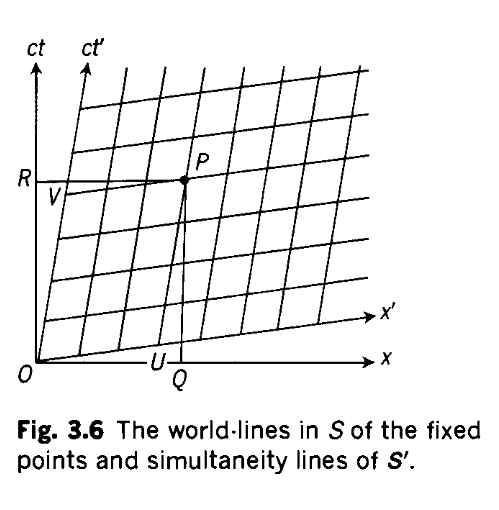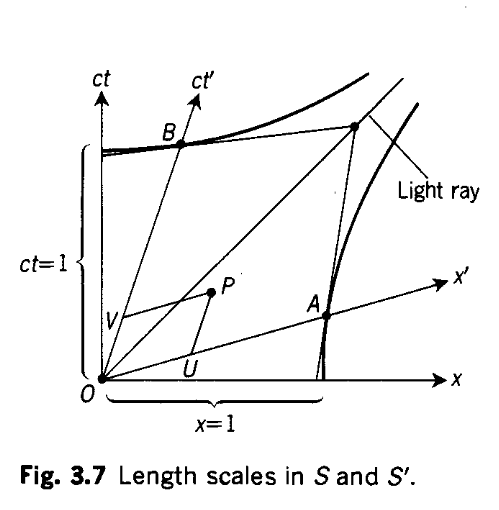-
Posts
4785 -
Joined
-
Days Won
55
Content Type
Profiles
Forums
Events
Everything posted by joigus
-
https://www.nature.com/articles/s43247-021-00313-5 (My emphasis.) This is what I meant. Graphite is one of the best lubricants, therefore reducing dissipation.
-
Not at 30'000 degrees --never mind Kelvin, centigrade or Fahrenheit.
-
Fair enough. Thank you.
-
I would say this is more or less a correct statement. Where do you think it's wrong, @Genady? Have I missed something?
-
This has become an escape clause - used too lightly. Common sense derives from experience. Subatomic world is far removed from common experience. How lightly is too lightly? That's your definition. 'Oblivion' Oblivion is something --according to my definition--, yet, it doesn't occupy any space. The word 'oblivion' is also something --according to my definition--, but it doesn't occupy any space. The concept of oblivion is also something --according to my definition--, but it doesn't occupy any space. And so on. No danger of incurring use-mention fallacy.
-
One exception to this is perhaps photons. But photons require a very special quantum treatment. Number of photons is not a conserved quantity, for example. They can interfere with each other[?] through a very big common 'wave function' if you want to call it that. But properly speaking, there is no wave function of a photon in the sense of something that gives you the probability for localisation of a photon. I'm overstretching the limits of language here. There are even states with no definite number of photons --coherent states.
-
They could form a very ephemeral state called a di-neutron and then decay to two neutrons. You could say that Higgs multiplets --which are neutral-- do combine to alter space, but with no changes over time. They fill up all of space with the result of giving every massive particle a mass. Neutrinos, OTOH, would do nothing much... You see, it depends on what neutral particles, and the couplings --interactions-- they have with each other and other particles. That's a very nice way to hit someone with protons...
-
LHC? Large hadron collider? 🤔
-
Legal and Human Rights Centre?
-
You said two protons, so they would repel each other and wouldn't likely ever meet. There are several factors that tell you so: 1) Electrostatic repulsion 2) Pauli's exclusion principle 3) No p-p bound state in QCD 3) already answers this, And as to, No. Interference in quantum mechanics only refers to different alternatives relative to one system. Example: The double slit experiment. Different components of one wave function interfere at a point. It's never about two distinct electrons, or two distinct protons, etc, interfering. Having said all that, if you chose to throw the protons at each other --instead of them being initially at rest-- they will scatter off each other, as happens in the LHC. The expectation of distance btw 2 protons is indeed a function of their mutual probability waves. They will be more likely to get farther apart as time passes. Did that help?
-
You're right in that it's not just a matter of hinging together a bunch of qualitative concepts. I'm sure it depends on how much dissipation, gravity, tectonic energy at play... So the quantitative argument is lacking there. The case of Mars is interesting because of the relatively low gravity, as compared to Earth. That's probably why Mount Olimpus and Valles Marineris are so huge when considering them with some kind of scale law in mind. Even though Mars has strong dissipation in the atmosphere*. It doesn't have that much dissipation underground --if at all--, as it has no plate tectonics. So in my mind, lower gravity and tectonic dissipation could easily account for it. It's interesting to notice though that minuscule satellites, like Phobos and Deimos, look more like potatos. Very low gravity and practically no dissipative processes. Seems to bode well with the qualitative idea. There must be a scale law involved, no doubt. I'm being quite vague though, I'm aware of it. ------- * But having had active geology and erosion processes in the remote past. (EDIT)
-
Good thinking. +1 In recent years, a cosmological theory to explain why the cosmos looks so flat --up to very large scales-- is being developed --Latham Boyle, Kieran Finn, Neil Turok, and others. The mechanism they propose is similar to what you're saying here. In fact, they use the Earth as an analogy. It's a combination of gravity and dissipative processes that does it. You need some fluidity, as Genady and Swansont said. So you need temperature, as J.C.Macswell pointed out. Because of plate tectonics, it would appear that bulges could potentially regenerate, thereby frustrating this process, and perhaps --from constant cooling of the Earth-- grinding the process to a halt. But dissipative mechanisms are constantly counteracting this tendency, with the result of flattening it out. Gravity does the final trick, depositing the ground pieces as close to the centre as it can.
-
This is not a chauvinistic society. It's a science-discussion network. You're thinking Euclidean. Your diagram shows only too clearly that you are. Because you're thinking Euclidean, there's a rigidity of sorts in your mind that forces you to conflate different reference frames --as you've been told here and elsewhere-- in order to shoehorn your picture into the Pythagorean theorem. Here's a series of pictures that tell you why: (from Ray D'Inverno, Introducing Einstein's Relativity, Oxford University Press.) So, again, IOW, who are the S and S' on diagram 3.6 and 3.7 from D'Inverno? If you dodge the question again and throw brand new Euclidean diagram, there isn't much else to talk about, is there? One final word about 'sentiments.' This is a recurring theme in science discussions. People often mistake dead-seriousness about the subject with grumpiness, or even anger. Nothing of the kind. I personally sympathise very much with everyone who's interested in science. People who know about the subject would be doing you no favour by indulging in a logic they know to be flawed. They would be doing themselves no favour either. Sorry, I forgot: My sentiments are in the right place. No sentiments about space-time, really. Only perhaps longing for a space-time that allows to go backwards in time. I have some unfinished business in the past.
-

BBC science news article [Antarctic and Arctic sounds]
joigus replied to paulsutton's topic in Science News
I blame Star Wars... -
Also, as pointed out above, no experimental exception to it has been found.
-
Not exactly... Sorry I wasn't very careful. There are further comments I'd like to make. It's all to do with efficiency actually being based a man-centred definition as roughly \( \eta=\frac{\textrm{output}}{\textrm{input}} \). If your input is pure 'work' --like in a refrigerator, electrical work--, you really don't care that much whether it's reversible or irreversible. It goes in the denominator of any reasonable definition of efficiency. If it's part of the 'internal definition of the cycles, it must always be reversible (meaning a form of energy that's stored in your system and can be given back.) If your output is pure work, it doesn't matter much whether it's reversible or irreversible either. It goes in the numerator in any reasonable definition of efficiency. After all, you don't care that much that your fan's energy, after it's hit your face and cooled it, gets lost in the air. It't important, though, to keep track of where it goes. Internal work, the work that's invested in making the engine cycle on, that one must be reversible. I'm finding difficult to distinguish what kind of engine this is, and so what efficiency formula has to be applied. If there are internal pieces of irreversible work/heat throughput, it could be a nightmare to analise in terms of Carnot's logic. @Ghideon perhaps has been able to understand you better. He certainly has tried harder than anybody to follow your logic. I'm trying to guess as I go, and draw some diagrams to clarify my own ideas and remember everything that could be involved or be relevant. And read everything that's been said. I wouldn't dream of proving Carnot wrong though. Carnot's reasoning is what it is. And it's so simple and incontrovertible that I can see no way how it could be wrong.
-
Have you read my previous comments? Irreversible work is, to all intents and purposes, indistinguishible from heat in any caloric analyses a couple of seconds after it's been delivered. It's not stored in the form of gravitational potential energy, charge in a capacitor, pressure in a gas, etc. All forms of work that can be 'given back' by the system. It must be included, as @sethoflagos shrewdly pointed out if I understood him correctly, as TdS=T(dSirreversible work+dSheat exchange) to the effects of every conceivable energy balance. If you take Carnot's efficiency formulae --any of them; heat engine, heat pump, refrigerator or José Carreras ("the other one"), irreversible work should be considered as heat, rather than work, as every Carnot recipe only speak of 'work' in the sense of 'reversible work,' not what you bluntly are calling 'work.' This is, of course, just an educated guess by yours truly, as I've never been brave enough to try to tell anything about an ungodly mess of pumps and fans, and Stirlings, and so on as concerns Carnot's analysis. I wouldn't even know how to begin. Does this go in the denominator? You know... As you're not distinguishing with any care the difference between irreversible and reversible work, and not taking any calorimetric measures, it's like trying to describe a platypus to a person that's willingly blindfolded and keeps telling you such thing cannot exist. It all sounds to me like 'sumfin fishy's goin' on, there ain't no platypus." I'm incapable of following your train of thought. There you are. I hope that clarifies the question as to why I can't clarify the question.
-
It not only "appears to." It does. And Carnot's formula tells you why. So much more so the closest your design is to Carnot's unattainable chimaera. Heat pump, or refrigerator have different definitions for efficiency, as efficiency is after all, an anthropocentric definition, as shown by the fact that for refrigerators and heat pumps --if I remember correctly--, work, instead of heat source, is what you put in, and thereby appears in the denominator. This, so I understood, was hinted at by Seth in a previous post.
-
@Tom Booth's reports and our answers remind me more and more of the lyrics of Space Oddity, by David Bowie,
-
Mee too. And dealing with neutrinos, there would be no way to keep it in.
-
A plasma of neutral particles... Interesting concept.
-

Plastic human mind (Split from Modeling the psychic space)
joigus replied to Lorentz Jr's topic in Speculations
Honestly... what a load of whataboutism. Grow up. Seriously. Let's get down to business... Tendencies towards conservatism, liberalism, and the like... It's not etched in your genes, but there are consistent claims that there must be a genetic component to them. Of course there are environmental factors. How could it be otherwise. I leave it to the experts to elaborate on that, as I'm not one of them. Clearly.




